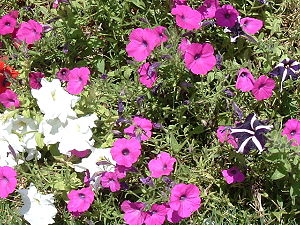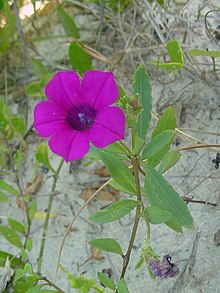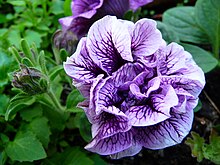Petunias
| Petunias | ||||||||||||
|---|---|---|---|---|---|---|---|---|---|---|---|---|

Petunia × hybrida |
||||||||||||
| Systematics | ||||||||||||
|
||||||||||||
| Scientific name | ||||||||||||
| Petunia | ||||||||||||
| Yuss. |
The petunias ( Petunia ) are a genus of plants within the nightshade family (Solanaceae). The approximately 16 species are distributed in the temperate to subtropical areas of South America . Several species are endemic to Brazil . The petunia species have adapted to different types of pollinators in different ways : to pollination by bees ( melittophilia ), to pollination by swarmers ( sphingophilia ) or to pollination by hummingbirds( Ornithophilia ). The garden petunia ( Petunia × hybrida ) is a hybrid produced from several species of the genus and is one of the most important ornamental plants . The different varieties are traditionally divided into four groups of varieties, of which 'Grandiflora' and 'Multiflora' are the most important.
description

Vegetative characteristics
Petunias are herbaceous plants . The aboveground parts of the plant are covered with simple, often sticky trichomes . The pairs or alternate arranged leaves may be pedunculated or sessile. The leaf blades are simple and have entire margins.
Generative characteristics
The flowers stand individually in single-forked zymous inflorescences and are accompanied by a pair of almost identical bracts .
The hermaphrodite flowers are five-fold with a double flower envelope , almost radial symmetry and smell more or less intense depending on the species. The bud cover is like a roof tile (imbrikat). The five sepals are only briefly fused. The often strikingly colored crown is funnel-shaped or cup-shaped. Within the genus only Petunia axillaris has completely white crowns, in all other species they are reddish-purple, red or pale blue. The dust bags open through longitudinal slits. The ovary consists of two compartments.
The two-compartment capsule fruits open up with crevices in the septum and contain a large number of seeds. The tiny seeds are round or angled. The seed coat (testa) is reticulated; this structure is due to the walls standing perpendicular to the surface of the seed, which are corrugated in all species. The seeds contain a straight embryo , the cotyledons are shorter than the rest of the embryo.
The chromosome number in Petunia s. Str. is 2n = 14.
Ingredients and ecology
Stems and leaves contain neither crystal sand nor drusen (deposits in plant cells), as is the case with some other genera of the nightshade family. The pericycle is fibrous, but the inner and outer phloem are not . Petuniasteroids - Ergostane- derived C28 steroids - have been detected in the leaves and stems . The substances protect the plants from being eaten by caterpillars.
The coloring of the crowns is due to various anthocyanins .
The petunia species have adapted in different ways to three different types of pollinators : The flowers of Petunia integrifolia and other species are adapted to pollination by bees ( melittophilia ) ; they are purple in color, hardly smell, produce little nectar and have a wide corolla tube into which the bees can crawl to get nectar or pollen . The white crowns of Petunia axillaris with narrow corolla tubes and plenty of nectar, which give off a strong scent at night, they are adapted to pollination by swarmers ( sphingophilia ). The flowers of Petunia exserta are adapted to the pollination by hummingbirds ( ornithophilia ) : The crown is red, the corolla lobes are bent back and the anthers and style protrude from the flower. The flowers hardly smell, but have a long corolla tube and produce plenty of nectar.
distribution
All Petunia species are native to temperate to subtropical South America. They occur in Brazil , Uruguay , Argentina , Paraguay and Bolivia . The most widespread has Petunia axillaris , which can be found in the southern Rio Grande do Sul , in Uruguay, the northern half of Argentina, the middle of Paraguay and in the south of Bolivia.
A large number of species are endemic in Brazil : Petunia mantiqueirensis only occurs in southern Minas Gerais , Petunia scheideana , Petunia reitzii and Petunia saxicola only in Santa Catarina , Petunia altiplana and Petunia bonjardiensis only in the highlands of Santa Catarina and the adjacent areas in Rio Grande do Sul , Petunia litoralis and Petunia integrifolia subsp. depauperata in the eastern coastal areas of Santa Catarinas and Rio Grande do Suls, Petunia exserta , Petunia riograndensis and Petunia bajeensis only occur in the southern Rio Grande do Sul. Petunia interior and Petunia guarapuavensis occur in the highlands of Paraná and Santa Catarina, but also in northeastern Argentina, in Misiones .
Another species, Petunia occidentalis , is found in northwestern Argentina and southern Bolivia.
Systematics and distribution

External system
The genus Petunia is classically classified within the systematics of the nightshade family in the tribe Nicotianeae and there in the subtribe Nicotianinae. Molecular biological studies showed, however, that the Petunia cannot be classified in a common clade with the tobacco genus ( Nicotiana ) . In the family system of Richard Olmstead from 2007, the genus is classified together with the Bouchetia , Brunfelsia , Calibrachoa , Fabiana , Hunzikeria , Leptoglossis , Nierembergia and Plowmania in a clade called Petunieae.
For a long time the species of the genus Calibrachoa were also counted among the Petunia . Investigations of the relationship between the two genera using morphological and molecular biological methods have shown that both genera are monophyletic and the division of the genus is thus justified.
Internal system
Around 14 species are recognized within the genus Petunia in 2009:
- Petunia altiplana T.Ando & Hashim.
-
White-flowered petunia ( Petunia axillaris (Lam.) Britton, Sterns & Poggenb. ): It is native to Bolivia, Uruguay, Brazil and Argentina. With the subspecies:
- Petunia axillaris (Lam.) Britton, Sterns & Poggenb. subsp. axillary
- Petunia axillaris subsp. parodii (Steere) Cabrera
- Petunia axillaris subsp. subandina T.Ando
- Petunia bajeensis T. Ando & Hashim.
- Petunia bonjardinensis T.Ando & Hashim.
- Petunia exserta Stehmann : It occurs in Brazil.
-
Violet petunia ( Petunia integrifolia (Hook.) Schinz & Thell. , Syn .: Petunia inflata R.E.Fr. ), with the subspecies:
- Petunia integrifolia (Hook.) Schinz & Thell. subsp. integrifolia
- Petunia integrifolia subsp. depauperata (REFr.) Stehmann
- Petunia interior T.Ando & Hashim. : It occurs in Brazil.
- Petunia mantiqueirensis T.Ando & Hashim. : It occurs in the Brazilian state of Minas Gerais.
- Petunia occidentalis R.E.Fr. : It occurs in Bolivia and Argentina.
- Petunia reitzii L.B.Sm. & Downs
- Petunia saxicola L.B.Sm. & Downs
- Petunia Scheideana L.B.Sm. & Downs
- Petunia secreta Stehmann & Semir : It occurs in Brazil.
Molecular biological investigations within the genus showed that Petunia axillaris with all three subspecies, Petunia exserta and Petunia occidentalis, together form a monophyletic group that is opposed to the other species of the genus.
The following species were assigned to the genus Calibrachoa according to morphological characteristics , but not yet moved to this genus in 1999 according to the rules of biological nomenclature :
- Petunia alpicola L.B.Sm. & Downs
- Petunia helianthemoides Sendtn.
- Petunia kleinii L.B.Sm. & Downs
- Petunia ledifolia Sendtn.
- Petunia variablis R.E.Fr.
Botanical history
The genus Petunia was established in 1803 by Antoine-Laurent de Jussieu . The generic name Petunia is derived from Petun , the Brazilian native word for tobacco . Together with the genus, Jussieu also first described the two species Petunia parviflora and Petunia nyctaginiflora . The latter, however, was first described by Jean-Baptiste de Lamarck as Nicotiana axillaris as early as 1793 , so that Petunia axillaris is the valid name of this species. The last complete revision of the genus Petunia was carried out in 1911 by Robert Elias Fries , who distinguished a total of 27 species, of which he published the first description of twelve species. The definition of the type species of the genus comes from Nathaniel Lord Britton and Addison Brown , who in 1913 selected the species first mentioned by Jussieu, i.e. Petunia parviflora .
In 1985, HJW Wijsman and JH de Jong published a study on the basis of which they defined two groups within the genus Petunia , as it was understood in the sense of Jussieu, and proposed them as separate genus. They transferred species with a chromosome number of 2n = 14 to the genus Stimoryne , a name introduced by Constantine S. Rafinesque-Schmaltz in 1836 , and left the remaining species with a chromosome number of 2n = 18 together with the then valid type species Petunia parviflora in of the genus Petunia . However, this would have meant that the garden petunia Petunia × hybrida would no longer have belonged to the genus Petunia . To circumvent this problem, Onno Winjands et al. In 1986 the name Petunia was preserved by using the second species named by Jussieu as a type species, although according to the rules of the ICBN , the species described first must always be used as the lectotype of a genus. The next valid name for the rest of the genus in the sense of Jussieus was Calibrachoa , this name was used in 1825 by Pablo de La Llave and Juan José Martinez de Lexarza for Calibrachoa procumbens (now a synonym for Calibrachoa parviflora ). Also in view of the unusual nature of this approach, the proposal by Wijnands et al. adopted by the Committee for Spermatophyta with a vote of 10: 1.
However, the work of the research group around Wijsman only assigned some of the known species to one or the other genus, so that initially the exact scope of the Petunia and Calibrachoa was not defined. Other researchers - João Renato Stehmann and William D'Arcy - made these assignments and transferred other species to the genus Calibrachoa . Five species that are morphologically assigned to the Calibrachoa and have a chromosome number of 2n = 18 have not yet been formally assigned to the genus.
This is also discussed further. But the formal recombinations of the Calibrachoa species have taken place. Some species seem to belong to Petunia after all .
use
Petunias are one of the most popular ornamental plants because of their large, open flowers in different colors . The first species raised in culture is said to have been Petunia axillaris in 1823 , and in 1825 an article about this species was published in Curtis's Botanical Magazine . The second cultivated species, Petunia integrifolia , first bloomed in July 1831 in the Glasgow Botanical Garden.
The garden petunia ( Petunia × hybrida ) available today is a hybrid of these two species. The exact origin of the hybrid can no longer be traced, however, a 1918 edition of Curtis's Botanical Magazine indicates that the original seeds were purchased in 1834 from a breeder named Atkins from Northampton . In addition, the breeder Ernst Benary from Erfurt was assigned the greatest importance as a breeder of petunias at the time. The different varieties are traditionally divided into four groups of varieties, of which 'Grandiflora' and 'Multiflora' are the most important.
Genetically modified petunias
At the beginning of 2017, the Finnish Food Safety Authority detected genetic modifications in orange-flowered petunia varieties, the cultivation and marketing of which are not permitted in Europe and the USA. The proof was also confirmed in Germany by the Federal Office for Consumer Protection and Food Safety (BVL). These investigations revealed transgenes in 46 different varieties. In-depth molecular biological investigations showed that the transgene comes from a genetically modified petunia into which a gene from maize was inserted at the Max Planck Institute for Plant Breeding Research in Cologne in 1986 in order to produce petunias with orange flowers. These petunias were integrated into breeding programs at various institutes and also tested in field trials. Since the gene change, depending on other genes, is not always recognizable by orange flowers, it is assumed that this could trigger an unwanted spread. The BVL emphasizes that the information currently available does not give any reason to derive risks for human health or the environment from the occurrence of genetically modified petunias on the market. Since petunias are usually annual ornamental plants and neither the plants nor the seeds are hardy, it is hoped that the unauthorized GM plants will disappear through the ordered destruction of the genetically modified petunias.
supporting documents
Individual evidence
Most of the information in this article has been taken from the sources given under literature; the following sources are also cited:
- ↑ a b c João Renato Stehmann, João Semir: A New Species and New Combinations in Calibrachoa (Solanaceae). In: Novon , Volume 7, 1997, pp. 417-419.
- ↑ a b c d e Sumei Chen et al .: Phylogenetic analysis of the genus Petunia (Solanaceae) based on the sequence of the Hf1 gene. In: Journal of Plant Research , Volume 120, Number 3, May 2007, pp. 385-397. doi : 10.1007 / s10265-006-0070-z
- ↑ a b c Hitoshi Watanabe et al .: Three Groups of Species in Petunia sensu Jussieu (Solanaceae) inferred from the intact seed morphology. In: American Journal of Botany , Volume 86, Number 2, 1999, pp. 302-305.
- ↑ a b Eckart Eich: Solanaceae and Convolvulaceae: Secondary Metabolites Biosynthesis, Chemotaxonomy, Biological and Economic Significance (A Handbook). Springer Verlag, Berlin, Heidelberg, 2008, ISBN 978-3-540-74540-2 . doi : 10.1007 / 978-3-540-74541-9
- ↑ Thomas Gübitz et al .: Petunia as a Model System for the Genetics and Evolution of Pollination Syndromes. In: T. Gerats and J. Strommer (eds.): Petunia - Evolutionary, Developmental and Physiological Genetics , Springer Verlag, 2009, ISBN 978-0-387-84795-5 , pp. 29-49.
- ↑ Armando T. Hunziker: The Genera of Solanaceae. ARG Gantner Verlag KG, Ruggell, Liechtenstein 2001, ISBN 3-904144-77-4 .
- ↑ Richard G. Olmstead, Lynn Bohs: A Summary of Molecular Systematic Research in Solanaceae: 1982-2006. In: DM Spooner et al. (Ed.): Solanaceae VI: Genomics Meets Biodiversity , ISHS Acta Horticulturae 745, June 2007, ISBN 978-90-6605-427-1 .
- ↑ Claudia dos Reis, Maria das Graças Sajo, João Renato Stehmann: Leaf Structure and Taxonomy of Petunua and Calibrachoa (Solanaceae). In: Brazilian Archives of Biology and Technology , Volume 45, Number 1, March 2002, pp. 59-66.
- ^ Toshio Ando et al .: Phylogenetic Analysis of Petunia sensu Jussieu (Solanaceae) using Chloroplast DNA RFLP. In: Annals of Botany , Volume 96, 2005, pp. 289-297. doi : 10.1093 / aob / mci177
- ^ João Renato Stehmann et al .: The Genus Petunia. In: T. Gerats, J. Strommer (Ed.): Petunia - Evolutionary, Developmental and Physiological Genetics , Springer Verlag, 2009, pp. 1-28, ISBN 978-0-387-84795-5 .
- ^ A b c d e Petunia in the Germplasm Resources Information Network (GRIN), USDA , ARS , National Genetic Resources Program. National Germplasm Resources Laboratory, Beltsville, Maryland. Retrieved December 1, 2017.
- ↑ a b Kenneth C. Sink: Taxonomy , In: Kenneth C. Sink (Ed.): Petunia , Springer Verlag, 1984, pp. 3-9, ISBN 3-540-13472-7 .
- ↑ a b c d Toshio Ando, Yoshihiro Ueda and Goro Hashimoto: Historical Survey and Present Status of Systematics in the Genus Petunia Jussieu (Solanaceae) . In: Tech. Bull. Fac. Hoard. Chiba Univ. , Volume 45, 1992, pp. 17-26.
- ^ NL Britton, HA Brown: An Illustrated Flora of the Northern United States and Canada. , Volume III, Charles Scribner's Sons, New York, 1913, p. 171. Scanned in at biodiversitylibrary.org
- ^ A b John T. Kartesz et al .: Nomenclatural Notes for the North American Flora I. In: Phytologica , Volume 67, Number 6, 1989, pp. 461-467.
- ↑ Kei-Ichiro Mishiba, Toshio Ando, Masahiro Mii, Hitoshi Watanabe, Hisashi Kokubun, Goro Hashimoto, Eduardo Marchesi Nuclear DNA Content as an Index Character Discriminating Taxa in the Genus Petunia sensu Jussieu (Solanaceae). In: Annals of Botany , Oxford, Volume 85, 2000, pp. 665-673. on-line.
- ^ Toshio Ando, Hisashi Kokubun, Eduardo Marchesi, E. Suárez, I. Basualdo: Phylogenetic Analysis of Petunia sensu Jussieu (Solanaceae) using Chloroplast DNA RFLP. In: Annals of Botany , Oxford, Volume 96, Issue 2, 2005, pp. 289-297. on-line.
- ↑ John Sims (Ed.): Petunia nyctaginiflora. Large flowered Petunia . In: Curtis's Botanical Magazine , Volume 52, London, 1825, Seq. 2552.
- ↑ Tom Gerats, Michiel Vandenbussche: A model system for comparative research: Petunia. In: Trends in Plant Science , Volume 10, Number 5, May 2005, pp. 251-256. doi : 10.1016 / j.tplants.2005.03.005
- ↑ David Prain (Ed.): Petunia integrifolia . In: Curtis's Botanical Magazine , Volume 144, 4th Series, Issue 14, London, 1825, Seq. 8749.
- ↑ Gordon Cheers (Ed.): Botanica , 2003, p. 657, ISBN 3-8331-1600-5
- ↑ K. Servick: The strange case of the orange petunias. In: Science 356 (6340), 2017, p. 792. doi: 10.1126 / science.356.6340.792
- ↑ Genetically modified petunias also in Germany - investigation authorities confirm Finnish results. Federal Office for Consumer Protection and Food Safety (BVL), technical report from May 22, 2017.
- ↑ Haselmair-Gosch, C., et al. (2018). Great Cause - Small Effect: Undeclared Genetically Engineered Orange Petunias Harbor an Inefficient Dihydroflavonol 4-Reductase. Front Plant Sci 9 (149): 149. doi: 10.3389 / fpls.2018.00149
literature
- T. Gerats, J. Strommer: Petunia - Evolutionary, Developmental and Physiological Genetics. Springer Verlag, 2009, ISBN 978-0-387-84795-5 .
- Armando T. Hunziker: The Genera of Solanaceae. ARG Gantner Verlag KG, Ruggell, Liechtenstein 2001, ISBN 3-904144-77-4 .
- William D'Arcy, A. Rakotozafy: Famille 176 - Solanaceés. In: Flore de Madagascar et des Comores , Muséum national d'histoire naturelle, Paris 1994, ISBN 2-85654-197-6 .



